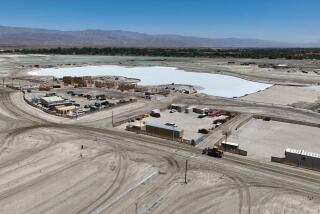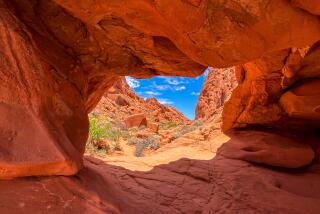Old bones of contention
LAS VEGAS — Local real estate agent Sandy Croteau made a somewhat surprising pitch as she traipsed through a vacant, gravel-filled wash: She wants to spare the expanse from home developers.
Trying to halt this city’s growth may be a Sisyphean task, but Croteau, 60, is counting on help from some sun-worn mammoth bones. About 10,000 bison, camel and mammoth fossils have been unearthed in recent years in a nearly 13,000-acre ribbon of the Upper Las Vegas Wash just south of Desert National Wildlife Refuge. And with builders champing to get at the property, the federal Bureau of Land Management must figure out how much of the land to preserve.
Acknowledging the fossils’ archeological import, Las Vegas officials have backed a plan that would shield about one quarter of the wash from development. But, they argue, conserving the entire area would thwart growth north of the city, where there is still room for homes and water and sewer lines.
With streets nearby already lined with bulldozers or adjacent subdivisions, Croteau and other activists have gathered hundreds of signatures in support of protecting the entire stretch.
“The first time I saw this, it changed my life,” said Croteau, her shadow darkening mammoth bones still in the dirt. “Do we really need a Quickstop here?”
The grass-roots campaign comes at a time when Las Vegas and its suburbs -- like a number of booming areas across the West -- are creeping into desert once dismissed as the boonies. Sin City’s population has doubled since 1990, and North Las Vegas’ has quadrupled. Though the housing market has slowed in recent months, officials still expect that much of the region’s remaining land will be developed.
“It’s a race to set aside these valuable places before homes are built,” said Kathleen Springer, senior curator for geological sciences at the San Bernardino County Museum, whose scientists have been unearthing the fossils.
The Upper Las Vegas Wash is a bleak swath dotted with the rare Las Vegas bearpoppy, an occasional discarded sofa and crushed beer bottles -- a spot used mostly by dirt bikers, ATV riders and paintballers.
A few years ago, when power lines were due to be installed in the area, scientists from the museum performed a preliminary survey and walked out with thousands of bones -- some thought to be nearly 100,000 years old.
When the BLM asked the scientists to return in 2003, they discovered more than 400 potential fossil sites and excavated a dozen of them, Springer said. Scientists are convinced that the wash is packed with bones that could aid their understanding of climate change and how behemoth animals subsisted during the Ice Age. “It almost gives me goose bumps,” Springer said.
Las Vegas City Councilman Steve Ross, whose district includes the wash, said he would make sure identified fossil sites are guarded. “But am I dedicated to blocking off the whole desert?” he said. “Absolutely not.”
The BLM is considering a range of options and is expected to announce a decision next year, said Gayle Marrs-Smith, who oversees the agency process.
Meanwhile, Croteau and other members of Protectors of Tule Springs -- as the wash is known locally -- are lobbying for it to become a national conservation area.
Helen Mortensen of the Archaeo-Nevada Society went out with Croteau one recent day to survey the wash, which is as wide as a football field and brims with water when it rains.
It may look scrubby, Mortensen said, but “this could explain early man’s interaction with Ice Age animals. We don’t know. There’s so much we don’t know.”
--
More to Read
Sign up for Essential California
The most important California stories and recommendations in your inbox every morning.
You may occasionally receive promotional content from the Los Angeles Times.










